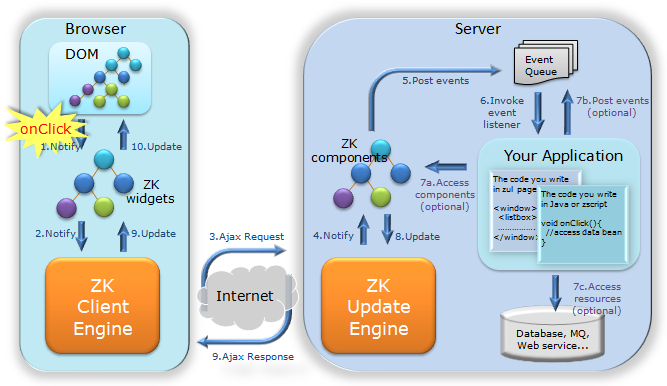An Introduction to ZK's Server client Fusion Architecture"
Tmillsclare (talk | contribs) |
Tmillsclare (talk | contribs) m (Redirected page to ZK Essentials) |
||
| (8 intermediate revisions by 4 users not shown) | |||
| Line 1: | Line 1: | ||
| + | #REDIRECT [[ZK Essentials]] | ||
| + | |||
{{ZKEssentialsPageHeader}} | {{ZKEssentialsPageHeader}} | ||
[[Image:architecture-s.png]] | [[Image:architecture-s.png]] | ||
| − | + | When a ZK application runs on the server, it can have access to the backend resources, assemble UI with components, listen to user's activity, and then manipulate components to update UI. All are done at the server. The synchronization of the states of the components between the browser and the server is done automatically by ZK and transparently to the application. | |
| − | + | When running at the server, the application can access full Java technology stack. User activities, including Ajax and Server Push, are abstracted to event objects. UI are composed of POJO-like components. ZK is the most productive approach to develop a modern Web application. | |
| − | + | With ZK's Server+client Fusion architecture, your application will never stop running on the server. The application could enhance the interactivity by adding optional client-side functionality, such as client-side event handling, visual effect customizing or event even UI composing without server-side coding. ZK enables seamless fusion from pure server-centric to pure client-centric. You can have the best of two worlds: productivity and flexibility. | |
{{ZKEssentialsPageFooter}} | {{ZKEssentialsPageFooter}} | ||
Latest revision as of 23:53, 28 March 2013
Redirect to:
![]() This article is out of date, please refer to http://books.zkoss.org/zkessentials-book/master/ for more up to date information.
This article is out of date, please refer to http://books.zkoss.org/zkessentials-book/master/ for more up to date information.
When a ZK application runs on the server, it can have access to the backend resources, assemble UI with components, listen to user's activity, and then manipulate components to update UI. All are done at the server. The synchronization of the states of the components between the browser and the server is done automatically by ZK and transparently to the application.
When running at the server, the application can access full Java technology stack. User activities, including Ajax and Server Push, are abstracted to event objects. UI are composed of POJO-like components. ZK is the most productive approach to develop a modern Web application.
With ZK's Server+client Fusion architecture, your application will never stop running on the server. The application could enhance the interactivity by adding optional client-side functionality, such as client-side event handling, visual effect customizing or event even UI composing without server-side coding. ZK enables seamless fusion from pure server-centric to pure client-centric. You can have the best of two worlds: productivity and flexibility.
